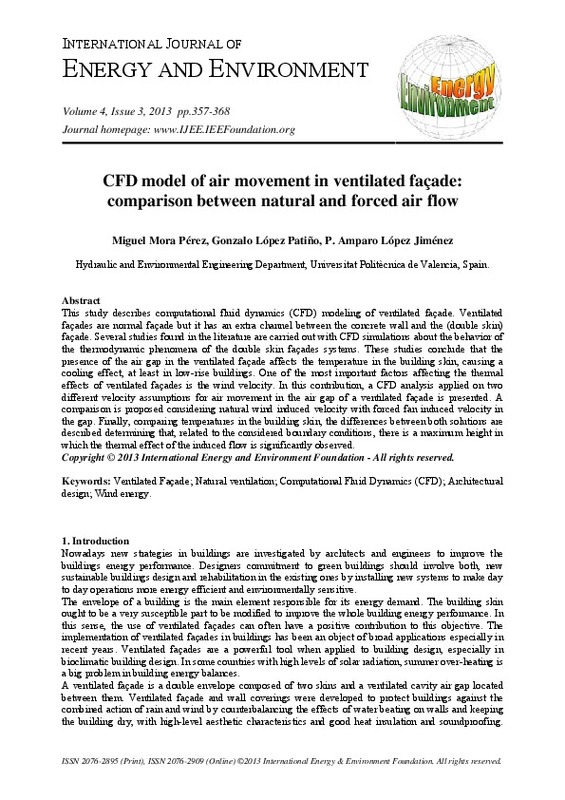JavaScript is disabled for your browser. Some features of this site may not work without it.
Buscar en RiuNet
Listar
Mi cuenta
Estadísticas
Ayuda RiuNet
Admin. UPV
CFD model of air movement in ventilated façade: comparison between natural and forced air flow
Mostrar el registro sencillo del ítem
Ficheros en el ítem
| dc.contributor.author | Mora Pérez, Miguel
|
es_ES |
| dc.contributor.author | López Patiño, Gonzalo
|
es_ES |
| dc.contributor.author | López Jiménez, Petra Amparo
|
es_ES |
| dc.date.accessioned | 2015-01-02T11:26:33Z | |
| dc.date.available | 2015-01-02T11:26:33Z | |
| dc.date.issued | 2013 | |
| dc.identifier.issn | 2076-2895 | |
| dc.identifier.uri | http://hdl.handle.net/10251/45770 | |
| dc.description.abstract | This study describes computational fluid dynamics (CFD) modeling of ventilated façade. Ventilated façades are normal façade but it has an extra channel between the concrete wall and the (double skin) façade. Several studies found in the literature are carried out with CFD simulations about the behavior of the thermodynamic phenomena of the double skin façades systems. These studies conclude that the presence of the air gap in the ventilated façade affects the temperature in the building skin, causing a cooling effect, at least in low-rise buildings. One of the most important factors affecting the thermal effects of ventilated façades is the wind velocity. In this contribution, a CFD analysis applied on two different velocity assumptions for air movement in the air gap of a ventilated façade is presented. A comparison is proposed considering natural wind induced velocity with forced fan induced velocity in the gap. Finally, comparing temperatures in the building skin, the differences between both solutions are described determining that, related to the considered boundary conditions, there is a maximum height in which the thermal effect of the induced flow is significantly observed. | es_ES |
| dc.language | Inglés | es_ES |
| dc.publisher | International Energy and Environment Foundation | es_ES |
| dc.relation.ispartof | International Journal of Energy and Environment | es_ES |
| dc.rights | Reconocimiento (by) | es_ES |
| dc.subject | Ventilated Façade | es_ES |
| dc.subject | Natural ventilation | es_ES |
| dc.subject | Computational Fluid Dynamics (CFD) | es_ES |
| dc.subject | Architectural design | es_ES |
| dc.subject | Wind energy. | es_ES |
| dc.subject.classification | MECANICA DE FLUIDOS | es_ES |
| dc.subject.classification | INGENIERIA HIDRAULICA | es_ES |
| dc.title | CFD model of air movement in ventilated façade: comparison between natural and forced air flow | es_ES |
| dc.type | Artículo | es_ES |
| dc.rights.accessRights | Abierto | es_ES |
| dc.contributor.affiliation | Universitat Politècnica de València. Departamento de Ingeniería Hidráulica y Medio Ambiente - Departament d'Enginyeria Hidràulica i Medi Ambient | es_ES |
| dc.description.bibliographicCitation | Mora Pérez, M.; López Patiño, G.; López Jiménez, PA. (2013). CFD model of air movement in ventilated façade: comparison between natural and forced air flow. International Journal of Energy and Environment. 4(3):357-368. http://hdl.handle.net/10251/45770 | es_ES |
| dc.description.accrualMethod | S | es_ES |
| dc.relation.publisherversion | http://www.ijee.ieefoundation.org/vol4/issue3/IJEE_01_v4n3.pdf | es_ES |
| dc.description.upvformatpinicio | 357 | es_ES |
| dc.description.upvformatpfin | 368 | es_ES |
| dc.type.version | info:eu-repo/semantics/publishedVersion | es_ES |
| dc.description.volume | 4 | es_ES |
| dc.description.issue | 3 | es_ES |
| dc.relation.senia | 251936 | |
| dc.identifier.eissn | 2076-2909 |






